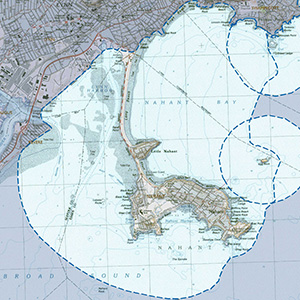Important Bird Area Sites in Massachusetts
Important Bird Area: Nahant Bay
Site Summary
Nominated By
Rick Heil
Size
4,800 acres
Towns and Counties
Lynn, Nahant, Swampscott; Essex
Ownership
town of Nahant, City of Lynn, Department of Conservation and Recreation, Mass Audubon, private
Major Habitats
60% marine/tidal, 20% urban/suburban, 8% coastal beach, 5% scrub-shrub wetland, 3% early successional shrubland, 3% marine forest, salt marsh, cultural grassland
Land Use
nature & wildlife, hunting/fishing, fisheries/aquaculture, suburban/residential, research, undeveloped
Serious Threats
invasive plants, introduced animals, residential/commercial development, disturbance to birds, recreational overuse
Minor Threats
succession, cowbird parasitism
IBA Criteria
- Category 1: Land Birds: The site is an important migratory stopover or seasonal concentration site for migratory land birds (e.g., warblers). Sites may also qualify on the basis of supporting exceptionally high densities of breeding species as shown from point counts or other surveys or if they represent "migrant traps" relative to surrounding areas. Strong consideration will be given to areas with consistently high overall species diversity.
- Category 2: Waterfowl: The site regularly supports 500 or more waterfowl at any one time. The designation "waterfowl" includes birds such as loons, grebes, cormorants, geese, ducks, coots, and moorhens.
Site Description
Nahant is essentially an island with a predominantly rocky shoreline connected to the mainland by a rather narrow tombolo along which runs a causeway. The main portion of Nahant lies roughly three miles southeast of the mainland and is well treed but heavily developed, with the exception of a swampy vegetated lowlands area, a golf course, two undeveloped headlands, a cemetery, several small woodlots, and a small thicket owned by Mass Audubon. Slightly closer to the mainland lies heavily developed Little Nahant, connected to the main portion of Nahant by a three-quarter-mile stretch (Short Beach). Nahant Beach (also known as Long Beach) connects the upland portion of Nahant to the mainland at the Lynn shore. This broad, gradually sloping, and sandy beach stretches for some two miles in length. It is backed by a narrow strip of low dunes (adjacent to the causeway), which is vegetated with traditional dune community plants, including Beach Plum, Beach Rose, bayberry, and dune grass, many of these recently reintroduced. The Lynn shore and Swampscott portions are sandy beaches closely backed by a large concrete seawall. At the eastern edge of Nahant Bay, north of East Point, lies Egg Rock, a towering granite ledge. Large algal blooms in Nahant Bay create a thick soupy consistency to the surf in some areas, regularly attracting thousands of shorebirds and Bonaparte's Gulls.
Current Conservation Status
Recreational beach use is a constant disturbance to roosting and foraging gulls and shorebirds as are jet skis to summering sea ducks. Fortunately, the largest concentration of birds is typically where the most algae accrues, deterring the general public from those areas. It would be very beneficial for roosting shorebirds if even a small portion of the beach near the Lynn border (where the algae most often accumulates) could be roped off as a no-entry area. Unleashed dogs are a frequent problem and often chase roosting or foraging birds. The few remaining woodlots on Nahant are gradually being converted to homesites. Water pollution may or may not be a problem. If water pollution feeds the algal blooms, it may actually be a contributing factor in regard to the bay's attractiveness to shorebirds and Bonaparte's Gulls.
Ornithological Significance
The Nahant Bay area contains diverse habitat, including sandy beaches, mudflats, mussel beds, a large shallow bay, rocky shorelines, brushland, and thickets. These attract a wide array of bird species including several that occur as migrants and are considered endangered, threatened, or of special concern. Lynn Harbor, which lies on the west side of the causeway, has mudflats and extensive mussel beds exposed at low tide, which attract large flocks of Common Eiders. Thousands of shorebirds and gull species are attracted to the shallow bay and beaches. The bay also hosts large flocks of sea and diving ducks from fall through spring, and a substantial number of immature scoters also summer in the area. Egg Rock has a large colony of nesting Double-crested Cormorants along with large gulls. The undeveloped and vegetated portions of Nahant provide habitat for migrant land birds, serving as a migrant trap, concentrating passerines in both spring and fall due to its insular location several miles off the southern Essex County coast. Large fallouts of neotropical and other migrants comparable to those occurring at Marblehead Neck often ensue, particularly in inclement weather.
Other Flora or Fauna of Significance
None known.
Data Sources
Published records in Bird Observer, Rick Heil, personal observation




